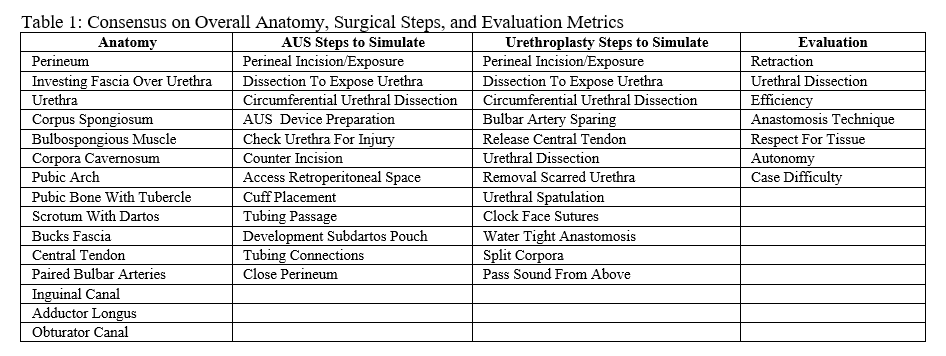Back
Introduction: The number of available simulation-based models for technical skills training in urology is rapidly increasing, and development of training around these procedures should follow a structured approach. Utilizing modern education theory previously used to develop a hydrogel model for penile prosthesis placement, we aim to establish the criteria for development of a hydrogel male genital simulation model for Urethroplasty and Artificial Urinary Sphincter Insertion using international expert consensus.
Methods: 19 international experts of genitourinary reconstructive surgery were invited to participate in a three phase consensus building approach (modified Delphi technique). A total of 39 unique questions with 155 sub questions over three rounds were included in 4 categories 1) Overall utility of the model 2) anatomical and procedural components, 3) tissue fidelity and 4) evaluation of performance. Components reaching a content validity index (CVI) =0.80 were utilized to fabricate a prototype model.
Results: 106 of the 155 (68.3%) questions reached the consensus benchmark. Regarding utility, consensus was reached that a non-biohazardous urethral model and simulation-based platform would be very beneficial and should be developed using a validated educational approach. The expert panel agreed the simulator should allow for surgical practice in a risk free environment and allow performance evaluation. Consensus was reached on key anatomical components (Table 1) including an initial training focus of a 2 cm proximal bulbar stricture. The panel agreed a model should allow flexible application of urethroplasty techniques such as grafts. The addition of an obturator canal was prompted from the group given desires for future urethral sling simulation. Furthermore, the experts approved a framework for a standardized evaluation metric for urethroplasty. They agreed motion analysis wearables for efficiency of movement and retrograde infusion test for anastomotic integrity have value as objective standardized feedback.
Conclusions: Harnessing the consensus of 19 international experts, the framework for a robust and bio-safe model for reconstructive urethral surgery with proposed objective evaluation parameters of surgical performance was achieved. Fabrication of the prototype based on this consensus statement is in development. SOURCE OF
Funding: None

Moderated Poster Session
Session: MP78: Trauma/Reconstruction/Diversion: Urethral Reconstruction (including Stricture & Diverticulum) II
MP78-14: International Expert Consensus on Development of a State of the Art Male Genital Simulation Model for Urethroplasty and Artificial Urinary Sphincter Insertion
Monday, May 1, 2023
1:00 PM – 3:00 PM CST
Location: S403
- AC
Andrew Cohen, MD
UCSF
Poster Presenter(s)
Introduction: The number of available simulation-based models for technical skills training in urology is rapidly increasing, and development of training around these procedures should follow a structured approach. Utilizing modern education theory previously used to develop a hydrogel model for penile prosthesis placement, we aim to establish the criteria for development of a hydrogel male genital simulation model for Urethroplasty and Artificial Urinary Sphincter Insertion using international expert consensus.
Methods: 19 international experts of genitourinary reconstructive surgery were invited to participate in a three phase consensus building approach (modified Delphi technique). A total of 39 unique questions with 155 sub questions over three rounds were included in 4 categories 1) Overall utility of the model 2) anatomical and procedural components, 3) tissue fidelity and 4) evaluation of performance. Components reaching a content validity index (CVI) =0.80 were utilized to fabricate a prototype model.
Results: 106 of the 155 (68.3%) questions reached the consensus benchmark. Regarding utility, consensus was reached that a non-biohazardous urethral model and simulation-based platform would be very beneficial and should be developed using a validated educational approach. The expert panel agreed the simulator should allow for surgical practice in a risk free environment and allow performance evaluation. Consensus was reached on key anatomical components (Table 1) including an initial training focus of a 2 cm proximal bulbar stricture. The panel agreed a model should allow flexible application of urethroplasty techniques such as grafts. The addition of an obturator canal was prompted from the group given desires for future urethral sling simulation. Furthermore, the experts approved a framework for a standardized evaluation metric for urethroplasty. They agreed motion analysis wearables for efficiency of movement and retrograde infusion test for anastomotic integrity have value as objective standardized feedback.
Conclusions: Harnessing the consensus of 19 international experts, the framework for a robust and bio-safe model for reconstructive urethral surgery with proposed objective evaluation parameters of surgical performance was achieved. Fabrication of the prototype based on this consensus statement is in development. SOURCE OF
Funding: None

